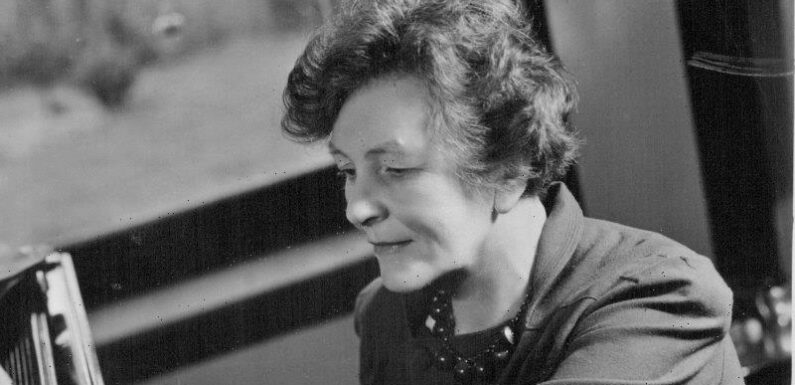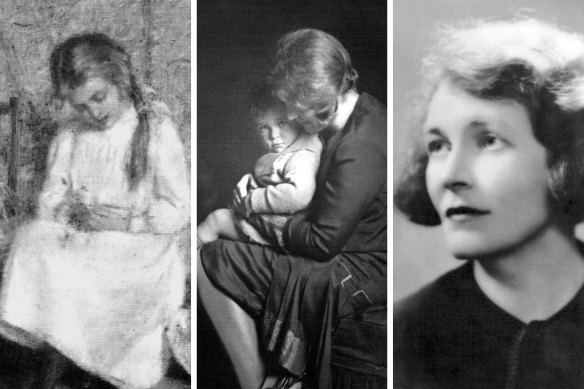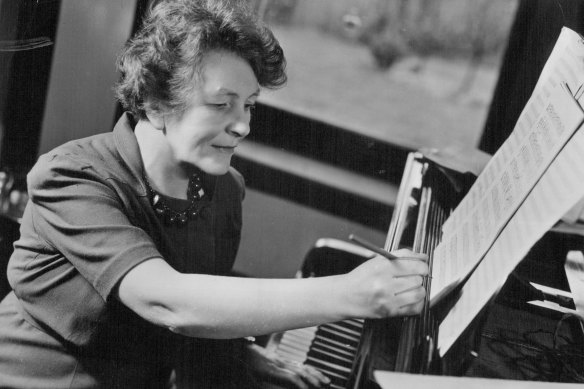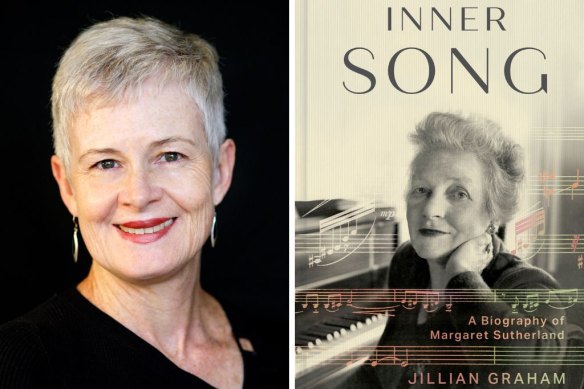
By Kathy Evans
From left,: a young Margaret by her aunt Jane, c. 1904; Margaret and son Mark, c. 1930; Margaret, c. 1937.Credit:Courtesy of the private collection of Margaret Sutherland’s papers held by Anthony Bunney
Tony Bunney’s earliest memories of his gran are of her kind, crinkled eyes, home-baked scones on a stained wood table and lemon cordial. He also remembers her wandering off to tinker at the piano, jotting down notes as she played. Little did he know that on those Sunday afternoon visits to her Kew home, his “ordinary” granny was creating some of Australia’s best classical music, and building an international legacy that he would one day look after.
No Stravinsky’s lunch at her house (the Russian composer forbade anyone to talk at the table when he was composing). Margaret Sutherland was not too grand to wear a pinny.
Sutherland is these days recognised as a titan of Australian classical music, responsible for bringing a reluctant antipodean audience in line with the musical currents of the early 20th century. A genius to some, she was loathed by others, who found her confrontational, stubborn and dogmatic.
“She was driven by the need to bring new music to people,” says author Jill Graham, whose biography of Sutherland, Inner Song, is released next month. “She didn’t wear her heart on her sleeve, but it came out in her music.”
Composer Margaret Sutherland in 1962.
Sutherland composed more than 200 works, the most famous being her groundbreaking 1925 Violin Sonata, which her teacher described as being “full of remarkable ideas” and “the best work by a woman that I know” (which, given the era, she took as a compliment).
While her compositions contained echoes of Vaughan Williams, Stravinsky and Bartok, dissonance was her trademark, reflecting perhaps an inner conflict and the sense of being out of step with the prevailing times.
Sutherland’s passionate desire to be both a composer and a mother was unusual in the 1920s, yet she made a brave attempt to do both. She was married to one of Australia’s first psychiatrists, Norman Albiston, who was said to be jealous of her talent, and saw her preoccupation with composing as a form of madness. Albiston, a music lover and sometime composer, wanted her to write only for children.
During their tempestuous marriage, he once bagged up all her music and threatened to hurl it in the river. She threw her score for Concertino for Piano and Orchestra on the fire, after Albiston humiliated her by turning up to its premiere with another woman. The couple finally divorced in 1948.
Jillian Graham’s Inner Song celebrates the life of composer Margaret Sutherland. Credit:MUP
“It was a terrible marriage,” says Graham. “In those days divorce was frowned upon; women didn’t come out of it very well. She was quite brave … but she was more content after she split with Norman.”
While Albiston found comfort in the arms of other women, Sutherland turned to nature, and what she called “le chant interieur”, the inner song that played continuously through her head. She revelled in both the settled pleasures of her garden and the mysteries that lay beyond in the bush, mountains and gullies. “I terribly love Australia,” she once proclaimed, and by some extraordinary alchemy turned her passionate feelings into music.
“It was fairly avant garde and people thought of it as quite intellectual, but I think there is a deep emotionalism in it as well,” says Graham, an academic and oboist who has spent the past three decades studying Sutherland’s life and works.
“It’s melancholic,” offers Bunney, who, through his role as custodian of her estate, has grown to love his grandmother’s work, despite being more of a Led Zeppelin and Jimi Hendrix fan. “It’s not your average classical music; it’s distinct,” he says.
The pensiveness is not surprising, since Sutherland, born into a family of liberal thinkers and intellectuals, suffered numerous losses. Her father and uncles all succumbed to a hereditary heart condition when they were in their 50s, and her sister, Dorothy, sickly from a young age, died aged 48.
The greatest tragedy, however, was the death of her daughter, Jennifer – Bunney’s mother – on a stormy Sunday afternoon in October 1971. She was on her way to Presbyterian Ladies College in Burwood to pick up her eldest daughter, Anna, from a school trip when a car ploughed into her. Bunney, who was 13 at the time, recalls how his mum asked if he and his siblings wanted to go with her. “We were watching TV, which was more important to us at that time. If we had gone, we would have ended up in the same situation.”
The tragedy sent the young Bunney “off the rails” and plunged Sutherland into a long depression that only lifted in the final years of her life. And it changed those Sunday afternoon visits to Kew, which became increasingly infrequent, as the family struggled to bear the weight of Jennifer’s absence.
While Sutherland’s heart produced the music, her head lobbied for social change. The orchestral piece Haunted Hills (1950), to be performed by the Melbourne Symphony Orchestra next month, was her longest single instrumental work, inspired by childhood walks in the Dandenong Ranges with her uncle and her awe at the sheer physical age of the hills, as well as the horror that was inflicted on the area’s traditional owners, the Bunurong and Woiworung people of the Kulin Nation. Her “sound picture” as she called it, captures their bewilderment, betrayal and despair in 15 minutes of clashing horns and assertive dissonance.
Her one and only opera, The Young Kabbarli, based on a story about the missionary Daisy Bates, was the first Australian opera ever to be recorded. She was also an early champion of the Indigenous tenor and activist Harold Blair and helped establish a trust to fund his studies.
Formidable, sharp and persistent, in the 1940s Sutherland led the initial push to construct what is now Arts Centre Melbourne. She laboured long and hard to petition for a space where “simple people” could be on intimate terms with music.
Finally, in the baking heat of November 1982, almost blind and in a wheelchair following a stroke, she was there to see the seeds of her labour bear fruit. Astoundingly, none of her music – nor that of any other Australian composer – was performed at its opening. It was only after her death at 86 two years later that a memorial concert of chamber works was held at Hamer Hall. A dressing room there bears her name in gold letters.
Sutherland’s contribution to Australian music was more widely recognised with an honorary doctorate from Melbourne University, an OBE and an Order of Australia gong. In the 1990s, her story piqued Graham’s interest; a mature-aged student at the time, she felt it spoke to people beyond the musical sphere, those whose inner song of loss, despair, triumph and sheer determination echoed Sutherland’s own.
For Bunney, himself no stranger to tragedy, looking after his grandmother’s estate helps keep her alive. He was 25 when she died, and still visiting her regularly at the nursing home in Malvern where she had finally found peace. “I have so many visions and images of her in my head,” he says. “It was so many years ago, but they are still there.”
Inner Song: A Biography of Margaret Sutherland, by Jillian Graham, is published by The Miegunyah Press on March 7. MSO’s Strauss’ Alpine Symphony, Debussy and Sutherland is at Hamer Hall on March 2 and 3. mso.com.au
A cultural guide to going out and loving your city. Sign up to our Culture Fix newsletter here.
Most Viewed in Culture
Source: Read Full Article


